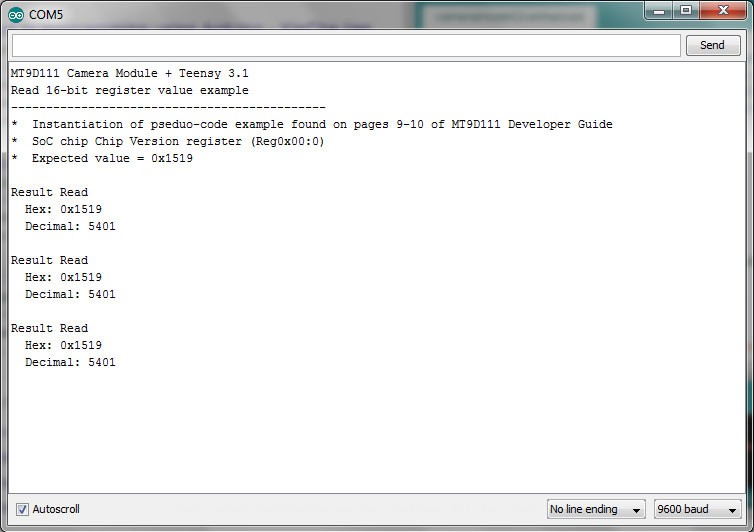
// Anthony Balducci - 05/15/2015
// MT9D111 16-Bit Register Read Example Arduino/Teensy 3.1 code
#include <i2c_t3.h> // Brian (nox771)'s I2C Library for Teensy, works much better than standard wire library.
// Configure the Teensy for 72 MHz (no overclocking) for most reliable results
void setup() {
analogWriteFrequency(20, 8000000); // Teensy 3.x specific code -- Specifies a 8 MHz clock out signal for XCLK on MT9D111 on pin 20
analogWrite(20, 128); // Starts PWM output with ~50% duty-cycle
Wire.begin(I2C_MASTER, 0x00, I2C_PINS_18_19, I2C_PULLUP_EXT, I2C_RATE_400); // Configures I2C to run as master, pins 18 (SDA) / 19 (SCL), external pull-up resistors and 400 KHz I2C Rate
Serial.begin(9600); // Open serial port at 9600 baud
delay(5000); // Optional delay -- Provides user five seconds to open serial monitor
Serial.println("MT9D111 Camera Module + Teensy 3.1");
Serial.println("Read 16-bit register value example");
Serial.println("---------------------------------------------");
Serial.println("* Instantiation of pseduo-code example found on pages 9-10 of MT9D111 Developer Guide");
Serial.println("* SoC chip Chip Version register (Reg0x00:0)");
Serial.println("* Expected value = 0x1519");
Serial.println();
}
void loop() {
delay(5000); // Optional delay between read tests
/* The MTD9111 Developer Guide states that 0xBA and 0xBB are the default read/write addresses respectively.
However, it is important to note, while converting 0xBA and 0xBA to binary at first 'appears' to give us
two distinct addresses:
(Write) 0xBA --> 10111010
(Read) 0xBB --> 10111011
The two values only different in their LSB (least significant bit), or in this case, the first value on the
'right'. The '0' / '1' in this position is what specifies the write (0) or read (1) condition accordingly.
In the Arduino language the LSB read/write portion is already built into the Wire.write / Wire.read commands,
thus the original register addresses specified must be truncated by the read/write bit to seven bits, leaving
us with 1011101 --> Ox5D in both cases.
*/
Wire.beginTransmission(byte(0x5D)); // Begin I2C transmission at MT9D111 default I2C device address
Wire.write(byte(0x00)); // Specify register to be read
Wire.finish(); // Wait to ensure transmission is complete
Wire.endTransmission(I2C_STOP); // End transmission, including required 'stop' command
Wire.requestFrom(byte(0x5D), 2, I2C_STOP); // Listen back for two bytes of data, with required 'stop' command once transmission complete
int16_t result = ((Wire.read() << 8) | Wire.read()); // Bit-shift the first byte, concatenate and store
// Output results
Serial.println("Result Read");
Serial.print(" Hex: ");
Serial.print("0x");
Serial.println(result, HEX);
Serial.print(" Decimal: ");
Serial.println(result);
Serial.println();
} // Loop till canceled Anthony
Anthony
Discussions
Become a Hackaday.io Member
Create an account to leave a comment. Already have an account? Log In.